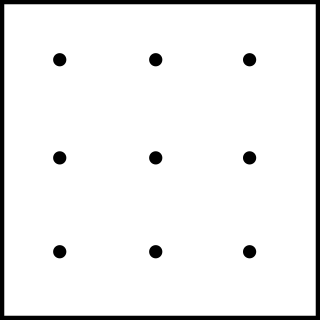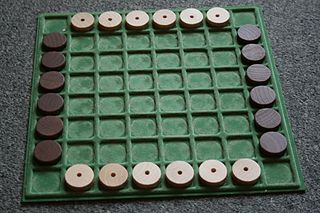
Tic-tac-toe, noughts and crosses, or Xs and Os is a paper-and-pencil game for two players who take turns marking the spaces in a three-by-three grid with X or O. The player who succeeds in placing three of their marks in a horizontal, vertical, or diagonal row is the winner. It is a solved game, with a forced draw assuming best play from both players.

Nine men's morris is a strategy board game for two players dating at least to the Roman Empire. The game is also known as nine-man morris, mill, mills, the mill game, merels, merrills, merelles, marelles, morelles, and ninepenny marl in English. The game has also been called cowboy checkers, and its board is sometimes printed on the back of checkerboards. Nine men's morris is a solved game, that is, a game whose optimal strategy has been calculated. It has been shown that with perfect play from both players, the game results in a draw.
Three men's morris is an abstract strategy game played on a three by three board that is similar to tic-tac-toe. It is also related to six men's morris and nine men's morris. A player wins by forming a mill, that is, three of their own pieces in a row.

Connect Four is a two-player connection rack game, in which the players choose a color and then take turns dropping colored tokens into a seven-column, six-row vertically suspended grid. The pieces fall straight down, occupying the lowest available space within the column. The objective of the game is to be the first to form a horizontal, vertical, or diagonal line of four of one's own tokens. Connect Four is a solved game. The first player can always win by playing the right moves.

3D tic-tac-toe, also known by the trade name Qubic, is an abstract strategy board game, generally for two players. It is similar in concept to traditional tic-tac-toe but is played in a cubical array of cells, usually 4x4x4. Players take turns placing their markers in blank cells in the array. The first player to achieve four of their own markers in a row wins. The winning row can be horizontal, vertical, or diagonal on a single board as in regular tic-tac-toe, or vertically in a column, or a diagonal line through four boards.

Sittuyin, also known as Burmese chess, is a strategy board game created in Myanmar. It is a direct offspring of the Indian game of chaturanga, which arrived in Myanmar in the 8th century thus it is part of the same family of games such as chess, and shogi. Sit is the modern Burmese word for "army" or "war"; the word sittuyin can be translated as "representation of the four characteristics of army"—chariot, elephant, cavalry and infantry.

Hasami shogi is a variant of shogi. The game has two main variants, and all Hasami variants, unlike other shogi variants, use only one type of piece, and the winning objective is not checkmate. One main variant involves capturing all but one of the opponent's men; the other involves building an unbroken vertical or horizontal chain of five-in-a-row.

Morabaraba is a traditional two-player strategy board game played in South Africa and Botswana with a slightly different variation played in Lesotho. The game is known by many names in many languages, including mlabalaba, mmela, muravava, and umlabalaba. The game is similar to twelve men's morris, a variation on the Roman board game nine men's morris.

Dara is a two-player abstract strategy board game played in several countries of West Africa. In Nigeria it is played by the Dakarkari people. It is popular in Niger among the Zarma, who call it dili, and it is also played in Burkina Faso. In the Hausa language, the game is called doki which means horse. It is an alignment game related to tic-tac-toe, but far more complex. The game was invented in the 19th century or earlier. The game is also known as derrah and is very similar to Wali and Dama Tuareg.

Nine Holes is a two-player abstract strategy game from different parts of the world and is centuries old. It was very popular in England. It is related to tic-tac-toe, but even more related to three men's morris, Achi, Tant Fant, Shisima, Picaria, and Dara, because pieces are moved on the board to create the 3 in-a-row. It is an alignment game.

Tant Fant is a two-player abstract strategy game from India. It is related to tic-tac-toe, but more closely related to three men's morris, Nine Holes, Achi, Shisima, and Dara, because pieces are moved on the board to create the 3 in-a-row. It is an alignment game.
Shisima is a two-player abstract strategy game from Kenya. It is related to tic-tac-toe, and even more so to three men's morris, Nine Holes, Achi, Tant Fant, and Dara, because pieces are moved on the board to create the 3-in-a-row. Unlike those other games, Shisima uses an octagonal board.

Picaria is a two-player abstract strategy game from the Zuni Native American Indians or the Pueblo Indians of the American Southwest. It is related to tic-tac-toe, but more related to three men's morris, Nine Holes, Achi, Tant Fant, and Shisima, because pieces can be moved to create the three-in-a-row. Picaria is an alignment game.
Pasang is a two-player abstract strategy board game from Brunei. The game is often referred to as Pasang Emas which is actually a software implementation of the traditional board game. The object of this game is to acquire the most points by capturing black and white tokens on the board. Black tokens are worth 1 point, and white tokens are worth 2 points. The board is initially laid out with all 120 black and white tokens in one of over 30 traditional patterns. Players choose a piece called a "ka" which is used to capture the tokens on the board. Each player's "ka" moves around the board capturing as many tokens as possible. As a note, the "kas" are the only mobile pieces in the game. The other pieces are stationary, and are captured by the "kas". Players must capture token(s) during their turn, or lose the game. When all tokens have been captured from the board, the player with the most points is the winner. However, if there are any tokens left on the board, and none can be captured on a player's turn, then that player loses the game, and the other player is the winner.
Tsoro Yematatu is a two-player abstract strategy game from Zimbabwe. Players first drop their three pieces onto the board, and then move them to create a 3 in-a-row which wins the game. It is similar to games like Tapatan, Achi, Nine Holes, Shisima, and Tant Fant. However, what makes this game unique is that pieces can jump over each other which adds an extra dimension in the maneuverability of the pieces.

Lines of Action is an abstract strategy board game for two players invented by Claude Soucie. The objective is to connect all of one's pieces into a single group. The game was recommended by the Spiel des Jahres in 1988.
Dala is a two-player abstract strategy board game from Sudan, and played especially by the Baggara tribes. The game is also called Herding the Cows. It is an alignment game with captures similar to that of the game Dara. Players first drop their pieces onto the board, and then move them orthogonally in an attempt to form 3 in-a-rows which allows a player to capture any of their opponent's piece on the board.
Connect 4x4 is a three-dimensional-thinking strategy game first released in 2009 by Milton Bradley. The goal of the game is identical to that of its similarly named predecessor, Connect Four. Players take turns placing game pieces in the grid-like, vertically suspended playing field until one player has four of his or her color lined up horizontally, vertically, or diagonally. Unlike its predecessor, Connect 4x4 uses a double grid, two different types of game pieces, and can be played by up to four people at once.
Mojo is a two-player, 3 in-a-row abstract strategy board game played with original and unique "thrice-sliced-dice". The pieces, handmade to order in India, are colored with non-toxic vegetable dye. The individual opposite ends of the pieces are marked with pips and numbered similar to regular dice - i.e. they total 7. It takes all 3 pieces of a color to make up a single die.

Tic-tac-toe is an instance of an m,n,k-game, where two players alternate taking turns on an m×n board until one of them gets k in a row. Harary's generalized tic-tac-toe is an even broader generalization. The game can also be generalized as a nd game. The game can be generalised even further from the above variants by playing on an arbitrary hypergraph where rows are hyperedges and cells are vertices.














